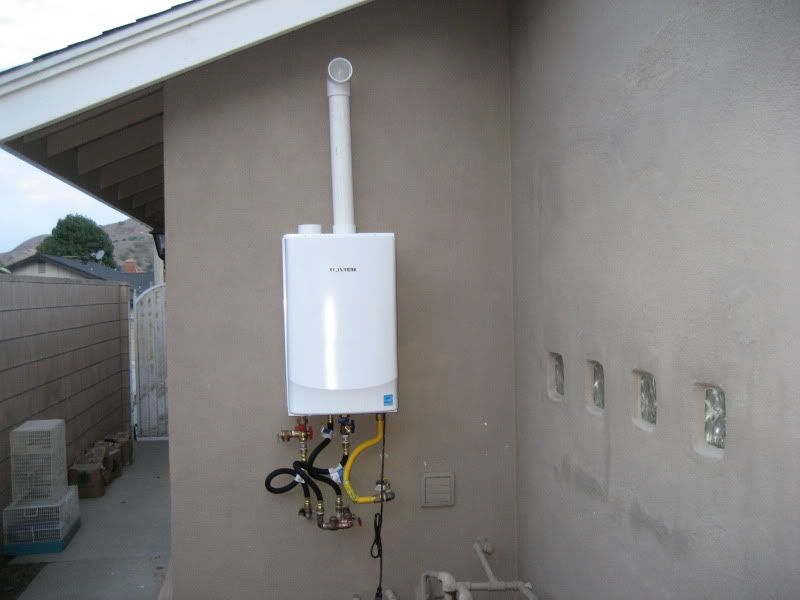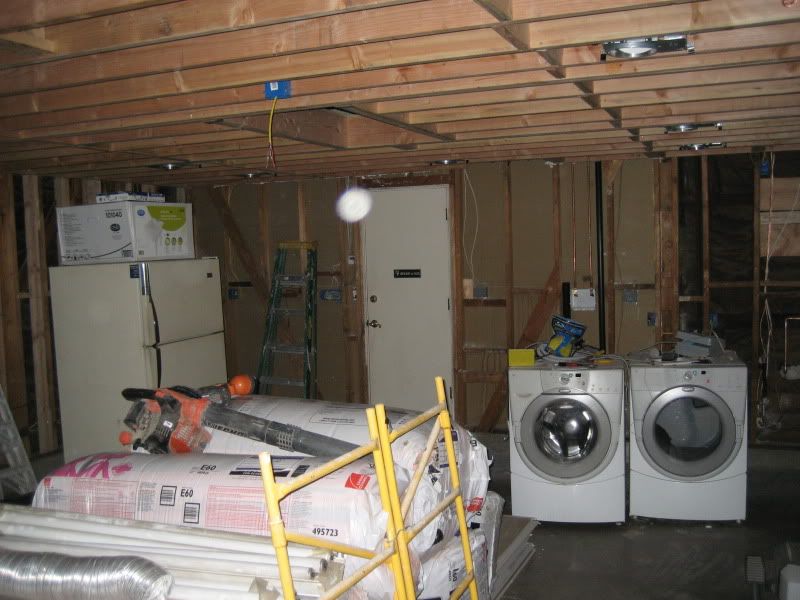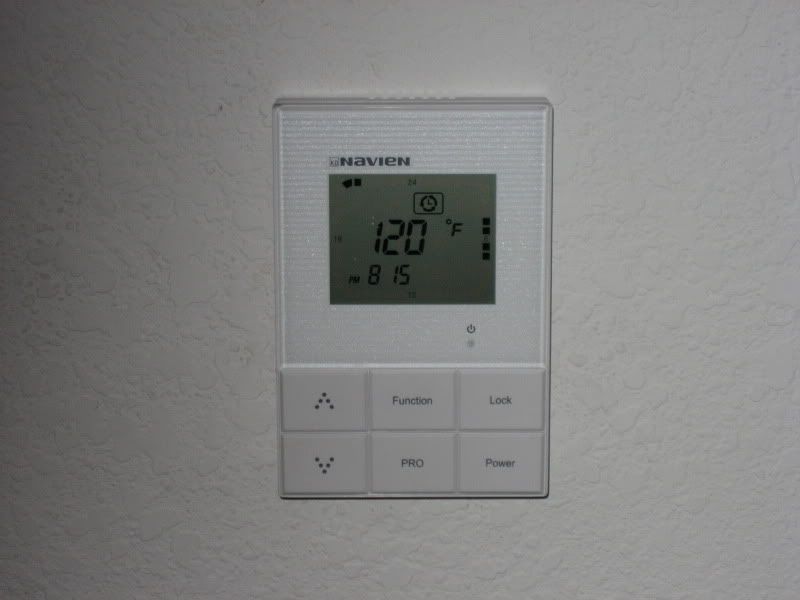You are using an out of date browser. It may not display this or other websites correctly.
You should upgrade or use an alternative browser.
You should upgrade or use an alternative browser.
Tankless waterheater
- Thread starter Coonash
- Start date

Help Support Plumbing Forums:
This site may earn a commission from merchant affiliate
links, including eBay, Amazon, and others.
Feel free to ask, as I will be the guinea pig for many. I have been looking at tankless water heaters for several years, and this wasn't an overnight decision. Because of the heavy rains expected in Southern California this week, I added a mushroom cap vent on both the intake and exhaust vents on the tankless, at a 2' difference. It began to cause a racket so I called the manufacturer, who said they can not be used because the exhaust is low on oxygen and the intake needs oxygen. Once I removed the mushroom cap, it worked fine. It's a learning process for sure!
I have installed many Rinnai Tankless heaters. All customers do is rave about them.
I recently decided to start selling/installing Navien heaters. With a PVC exhaust and intake they have made it reasonably cost efficent to install one.
The government is also offering a tax rebate to people who install tankless heaters. Couple that with the ease of installing a Navien and you can come real close to the cost of a standard heater installation.
I recently decided to start selling/installing Navien heaters. With a PVC exhaust and intake they have made it reasonably cost efficent to install one.
The government is also offering a tax rebate to people who install tankless heaters. Couple that with the ease of installing a Navien and you can come real close to the cost of a standard heater installation.
From what I understand, the purchase of a Navien Tankless water heater gives you a $300 tax rebate, until the money runs out. Also, you are correct about the 3" PVC exhaust, what a great idea. It pushes out several thousand BTU's of heat, but the exhaust is plastic pipe. This unit is very energy efficient to do this!
BRad704
Moderation
Ok, I need to bring up the idea of the recirc pump again... I was thinking about this randomly the other day, and I have an idea.
For an existing home installation, I can not run a return line through the walls, and should use the cold line as a return. BUT, what if I was able to run a return line thought the attic using that poly or "plastic" hose (sorry for the poor terminology)? Then I wouldnt have to deal with warm cold water for brushing my teeth, and we stay with the "conserving water" concept for both Hot and Cold... I could find a way to get the line down the wall, and under the sink, and also drop it into the garage where the water heater is located.
???
For an existing home installation, I can not run a return line through the walls, and should use the cold line as a return. BUT, what if I was able to run a return line thought the attic using that poly or "plastic" hose (sorry for the poor terminology)? Then I wouldnt have to deal with warm cold water for brushing my teeth, and we stay with the "conserving water" concept for both Hot and Cold... I could find a way to get the line down the wall, and under the sink, and also drop it into the garage where the water heater is located.
???
I believe what you are referring to is to make a return line out of Pex? This would work, provided your city allows Pex. when I inquired where I lived (La Verne, Ca.) the inspector told me, "absolutely not!" When I asked why not, he just began to hesitate and said their city doesn't allow it. When I inquired at Lake Havasu, I was told, "Of course, why would you install anything but?"
So my recommendation is to do your homework, make lots of calls, and go forward.
As I typed this I just thought of a solution. Why don't you install flexible copper line (rolled copper tubing) if Pex is not permitted? From what I understand, no city forbids copper, so you would be good to go.
So my recommendation is to do your homework, make lots of calls, and go forward.
As I typed this I just thought of a solution. Why don't you install flexible copper line (rolled copper tubing) if Pex is not permitted? From what I understand, no city forbids copper, so you would be good to go.
The recirc line your talking about is the optimal way to do this.
Just bring the line into the bottom of the heater at the drain cock(3/4 Female Iron Pipe) and install a pump on a timer as previously discussed. Grundfos makes one pretty reasonable. This can be done without a pump using gravity and Browning motion if the recirc line can be installed "pitching" towards the heater.
PEX has been approved in the International Plumbing Code since at least 2003. I'm pretty sure it has been adopted by all 50 states. Any City saying you cannot use it is full of it. Honestly if they say that, I would call Zurn and let them know. Their lawyers will surely tackle that problem for you.
Just bring the line into the bottom of the heater at the drain cock(3/4 Female Iron Pipe) and install a pump on a timer as previously discussed. Grundfos makes one pretty reasonable. This can be done without a pump using gravity and Browning motion if the recirc line can be installed "pitching" towards the heater.
PEX has been approved in the International Plumbing Code since at least 2003. I'm pretty sure it has been adopted by all 50 states. Any City saying you cannot use it is full of it. Honestly if they say that, I would call Zurn and let them know. Their lawyers will surely tackle that problem for you.
Last edited:
Here's our situation: currently heating water with an electric 40 gal heater that is on its way out. It's only my wife and I who live here - no kids, one bathroom. We run the dishwasher at night, or evening (not during shower time). We pay A LOT in electricity to keep that 40 gallons hot all day long with no one here. Our house is in Maine, so our basement is pretty cold most of the time.
We were thinking of installing a tankless LP unit in the large bathroom closet on the first floor, vented horizontally out through the wall. There's no easy way to vent vertically out the roof.
Thoughts about how big of a unit to go? Will the 4.2 GPM units from Paloma be enough? Any opinions about brands? The brands available around here are Paloma, Rheem, and Bosch.
We were thinking of installing a tankless LP unit in the large bathroom closet on the first floor, vented horizontally out through the wall. There's no easy way to vent vertically out the roof.
Thoughts about how big of a unit to go? Will the 4.2 GPM units from Paloma be enough? Any opinions about brands? The brands available around here are Paloma, Rheem, and Bosch.
The Navien and a few other high end TWH's have a recirculating punp with an input nipple built into it for ease of installation. This way, you don't need to add pieces which could void the warranty easily.
As far as Pex being allowed, I've called my 4 adjacent cities, who all said they were not allowed in existing homes, but could be potentually allowed with new built houses.
For "Ktaadn", TWH's also have the option for a horizontal vent and exhaust, so the installation could be up to your imagination, as long as it is allowable per your local codes.
Just remember, if you lose power, you will not have hot water and in the event of an earthquake or other disaster, you will not have those 40-50 gallons of reserve water supply. These are my only concerns right now. I'm considering a back up generator and as far as the water, my pool has 30,000 gallons of water if needed.
As far as Pex being allowed, I've called my 4 adjacent cities, who all said they were not allowed in existing homes, but could be potentually allowed with new built houses.
For "Ktaadn", TWH's also have the option for a horizontal vent and exhaust, so the installation could be up to your imagination, as long as it is allowable per your local codes.
Just remember, if you lose power, you will not have hot water and in the event of an earthquake or other disaster, you will not have those 40-50 gallons of reserve water supply. These are my only concerns right now. I'm considering a back up generator and as far as the water, my pool has 30,000 gallons of water if needed.
Is PEX rated for recirc systems?
I don't have any hard knowledge that it isn't, but when we installed a manifold system in my former bosses house, he looked into recirculating from the manifold box to the heater, but didn't because he said that the PEX people wouldn't warranty the pipe in that situation.
I don't have any hard knowledge that it isn't, but when we installed a manifold system in my former bosses house, he looked into recirculating from the manifold box to the heater, but didn't because he said that the PEX people wouldn't warranty the pipe in that situation.
I can not understand why Pex could not be used, provided you use their "red" tubing. When in doubt, a quick call to the company would answer it, as I am only guessing.
PEX is widely used in radiant heat systems. These systems are basically large "recirc" systems.
PEX is definitely approved in California. Near the end of the article it states that "installers, will be able to use PEX in all jobs in California"
I have used PEX for recirc lines in homes as well as restaurants.
PEX is definitely approved in California. Near the end of the article it states that "installers, will be able to use PEX in all jobs in California"
I have used PEX for recirc lines in homes as well as restaurants.
Last edited:
Thanks for clearing that up.
I just installed this Navien tankless that works with the solar tank..The tankless is the one with the condensing unit with built in re-circulating line! Now for the question....How important are the wye strainers?? Cause as you can see..I didnt install them! It showed them in the installation guide on the hot, cold and re-circ line but with the new lead law in Cali...They didnt have any instock at the supply house!! Thanks in advance!


They're pretty important. Especially on the inlet. The wye strainers are the first line of defense to keep debris out of the heat exchangers. I'm not saying its horrible, but I would definitely try to get one on the inlet at least.

This is where my contractor installed my tankless water heater. At the bottom of the picture, you will notice my gas meter. Is there a specific code which deals with a minimum distance between the meter and a water heater?
Also, we discovered by using the visible flexible line, the pressure was severely reduced in the house, so it was changed to solid 3/4" copper line, which allows full flow. Does anyone see any concerns with it?
Chris
Well-Known Member
The main concern I would have is why is it outside? Especially in our neck of the woods with the sun and heat.

The primary reason for relocating the water heater is because originally, it was just to the right of the garage door. It was an old "tanked" 50 gallon water heater on a 18" wooden pedestal. It was ugly, and took up too much room. Relocating the new tankless outside made everything work better. The new water lines routed perfectly, there was easy access to the gas line, we punched a dedicated circuit into the stucco, and there is no worry about fumes. Also, the PVC flashing thru the roof would have cost an additional $300-$400 for time and labor. The tankless really doesn't care where it is located, because it does not need to keep water warm, and only fires when needed. it is also rated for indoor or outdoor installation. The remote control for this unit is inside the garage, and protected from any water.

And here is the remote control for the tankless water heater, mounted on the interior wall.



